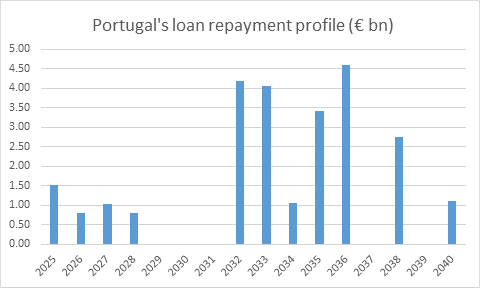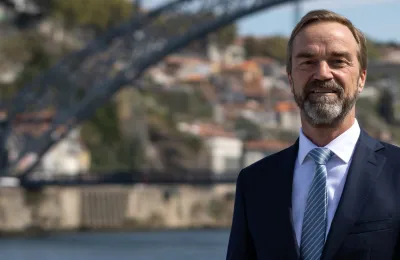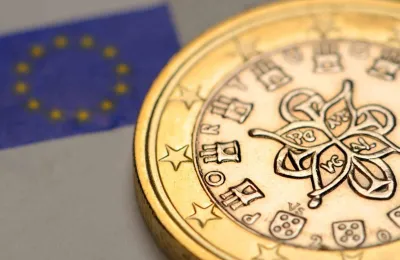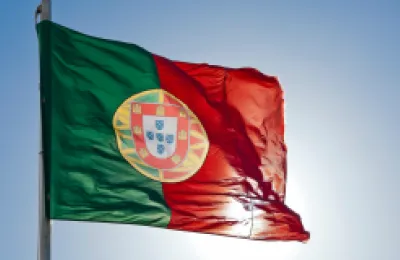
Portugal
Situation as of June 2024 (2023 ESM Annual Report)
Highlights
Programme overview
PROGRAMME TIMELINE FOR PORTUGAL
2011
EFSF disburses first loan tranche
Portugal returns to bond market
Portugal returns to economic growth after 4 years
2012
2013
2014
ESM programme outcomes
Economic adjustment and reforms
Portugal suffered from low GDP and productivity growth during the 2000s. Its competitiveness was undermined by rising labour costs and structural problems and led to persistent external imbalances. Public spending grew much faster than economic output, and both public and private debt levels rose in an environment of easy credit conditions. In early 2011, rising yields on Portugal’s sovereign bonds threatened the country’s ability to finance its government debt. Portugal requested financial assistance from the EU, the euro area and the IMF in April 2011.
The financial assistance package was tied to an economic adjustment programme, which included:
- A fiscal consolidation strategy, supported by structural and fiscal measures;
- Structural reforms to boost potential growth, create jobs, and improve competitiveness;
- Stabilisation of the financial sector through recapitalisation and deleveraging.
Thanks to the implementation of these reforms and measures, Portugal was able to return to market financing. A two-digit current account deficit was erased, the budget deficit shrank; GDP growth resumed in 2014 and continued until the Covid-19 crisis led to economic contraction across all of Europe in 2020.
After the programme
Following the completion of the programme in 2014, post-programme surveillance (PPS) has been carried out by the European Commission in liaison with the European Central Bank. The procedure involves regular review missions in the programme country to assess its economic, fiscal and financial situation. The ESM participates in PPS missions to fulfil the requirements of its Early Warning System, i.e. to assess a country’s capacity to repay its outstanding loans.
Portugal completed the early repayment of its IMF loans in December 2018. In September 2019, Portugal made an early repayment of €2 billion to the EFSF.
ESM country team coordinator for Portugal: Pilar Castrillo
Details of EFSF financial assistance for Portugal
| Date of disbursement | Amount disbursed | Cumulative amount disbursed | Initial final maturity | Revised final maturity |
|---|---|---|---|---|
| 22.06.2011 | €3.7 billion | €3.7 billion | 05.07.2021 | 01.07.2036 |
| 29.06.11 | €2.2 billion | €5.9 billion | 05.12.2016 | 03.12.2025 |
| 20.12.11 | €1 billion | €6.9 billion | 23.08.2025 | no change |
| 12.01.12 | €1.7 billion | €8.6 billion | 04.02.2015 | 30.01.2035 |
| 19.01.12 | €1 billion | €9.6 billion | 19.07.2026 | 18.07.2027 |
| 30.05.12 | €3.5 billion | €13.1 billion | 30.05.2032 | 30.05.2032 |
| 30.05.12 | €1.7 billion | €14.8 billion | 30.05.2032 | 30.05.2035 |
| 17.07.12 | €1.5 billion | €16.3 billion | 17.07.2038 | 17.07.2038 |
| 17.07.12 | €1.1 billion | €17.4 billion | 17.07.2038 | 17.07.2040 |
| 03.12.12 | €0.8 billion | €18.2 billion | 03.12.2028 | 03.12.2028 |
| 07.02.13 | €0.8 billion | €19 billion | 07.02.2022 | 07.02.2026 |
| 27.06.13 | €1.05 billion | €20.05 billion | n.a. | 27.06.2033 |
| 27.06.13 | €1.05 billion | €21.1 billion | n.a. | 27.06.2034 |
| 22.11.13 | €3.7 billion | €24.8 billion | n.a. | 22.11.2033 |
| 28.04.14 | €1.2 billion | €26 billion | n.a. | 28.04.2038 |
Weighted average maturity of loans: 20.8 years
Loan repayments
| Date of repayment | Amount repaid | Details |
|---|---|---|
| 17/10/2019 | €2 billion | Early repayment (voluntary) |
Explainer
How is Portugal’s economy performing?
Thanks to the implementation of reforms, Portugal has been successful in improving public finances, reinforcing the financial sector and bringing the economy back on a path of recovery. Portugal returned to economic growth in 2014 after four years of recession (1.4% in 2016, 1.8% predicted in 2017). Fiscal adjustment has been significant, with Portugal’s public deficit dropping from over 10% in 2009 to 1.8% (predicted) in 2017.
When did Portugal return to market financing?
Portugal returned to bond markets in May 2013, when it issued a 10-year bond with a yield of 5.67%. This shows that investors had quickly regained confidence in the Portuguese economy, as Portugal’s 10-year bond yields were over 16% in January 2012.
When will Portugal have to repay the EFSF loans?
Portugal will repay the principal of the loan tranches starting from 2025, and the repayment is scheduled to end in 2040. An early repayment of €2 billion was made to the EFSF on 17 October 2019.

How did Portugal use the programme funds?
The majority of the EFSF programme amount was used for budget financing needs, while a smaller portion was used for the purpose of recapitalisation of banks (Millennium, Banco BPI and Caixa General de Depositos).
What policy conditions did Portugal implement in exchange for financial assistance?
The financial assistance provided was conditional upon the implementation of a macroeconomic adjustment programme, with reforms in three main areas:
- A fiscal consolidation strategy, supported by structural-fiscal measures, aimed at setting the debt/GDP ratio on a downward path in the medium term;
- Structural reforms to boost potential growth, create jobs, and improve competitiveness;
- Stabilisation of the financial sector strategy based on recapitalisation and deleveraging, with efforts to safeguard the financial sector against disorderly deleveraging through market-based mechanisms supported by backstop facilities.
Was the full programme amount used?
No. Each of the three programme financing institutions (EFSF, IMF and EFSM) committed €26 billion to support Portugal’s programme, but the country did not request the last loan tranche from the EFSM and IMF. Additionally, Portugal has already started making loan repayments to the IMF, reducing their outstanding amount with the fund. This makes the EFSF currently Portugal’s largest creditor (€26 billion in loans).
Who contributed to the financial assistance package?
The programme for Portugal was agreed as follows:
€78 billion in external support over three years, comprising- €26 billion from the EFSF;
- €26 billion from the EFSM (European Financial Stabilisation Mechanism – an EU facility funded through bonds issued by the European Commission);
- €26 billion from the IMF.
Why did Portugal need financial assistance?
Portugal had suffered from low GDP and productivity growth for more than a decade before the crisis started. During this period, the low interest rates resulting from adoption of the euro boosted private and public consumption, but also indebtedness. Portugal’s competitiveness was undermined by rising labour costs and structural problems. Growth in public spending was much higher than economic growth. Fiscal risks intensified through the expansion of state-owned enterprises and public-private partnerships. In early 2011, rising sovereign yields drove Portugal into a severe economic crisis. The country became unable to refinance its debt at sustainable rates and therefore requested financial assistance from the EFSF, the EU and the IMF.








